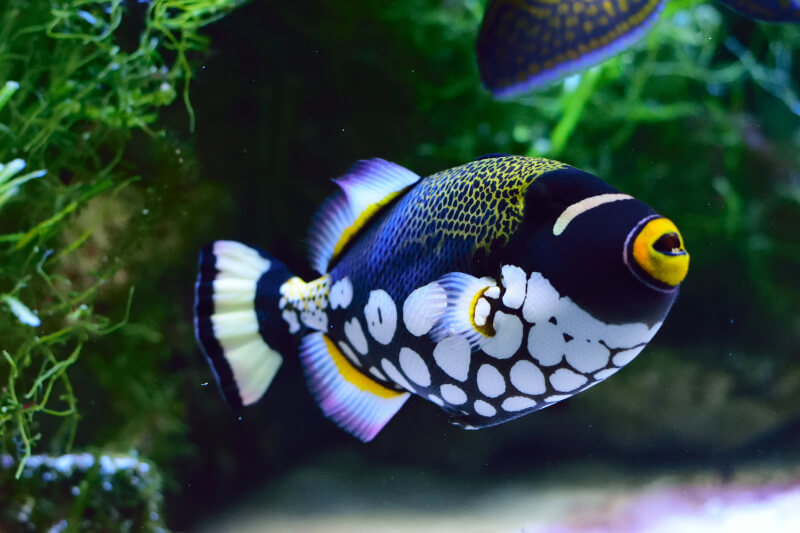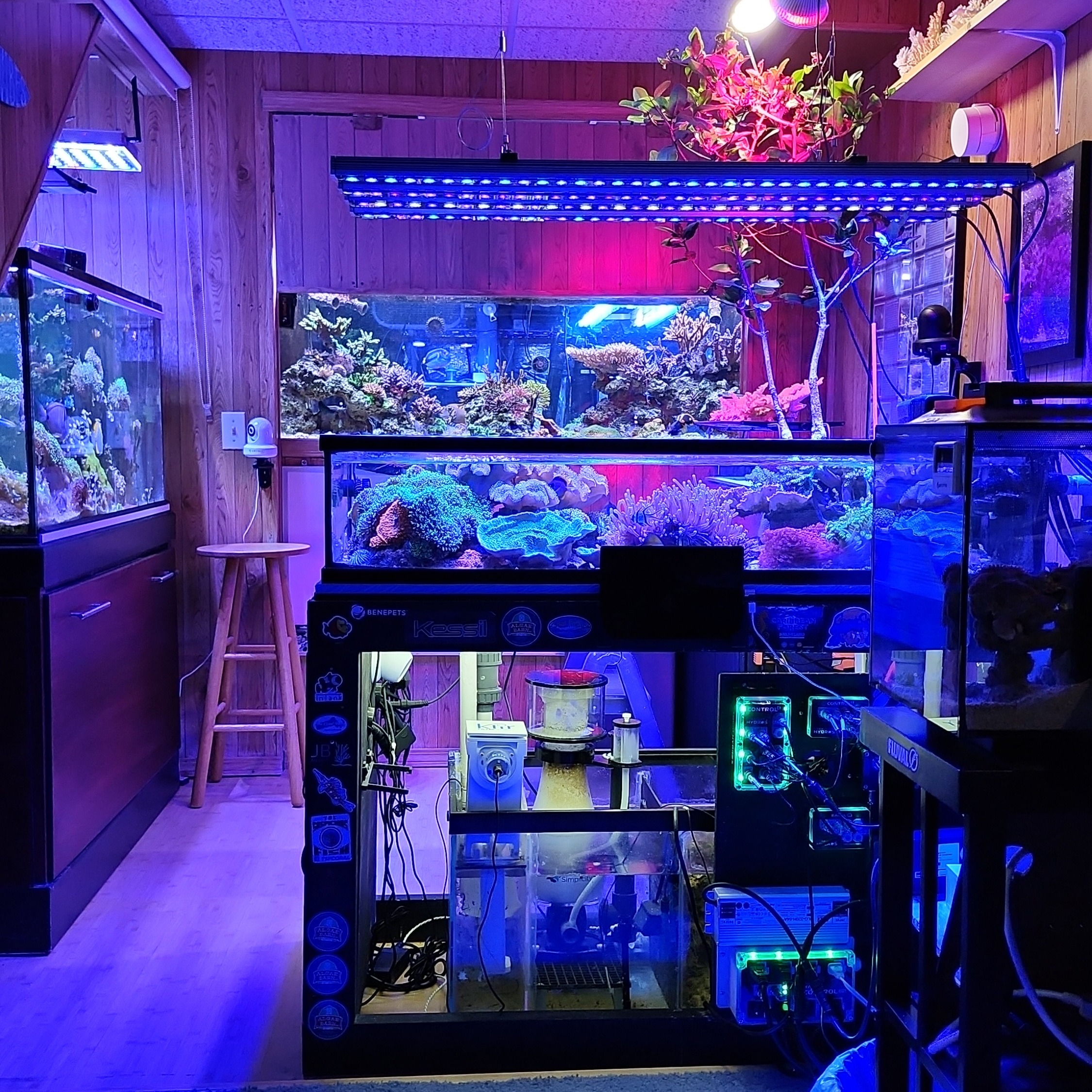Are you a fan of clown horror movies? If so, then you will enjoy reading this care guide about the Clown Triggerfish! We are just kidding (kind of) since these fish don’t look even close to a scary clown, on the contrary, they are quite pretty but they have a dark secret we’ll let you find out as you read 😉
Species Summary
Clown Triggerfish are a unique species with vibrant coloring and unusual behaviors that make them an excellent addition to an aquarium with tropical conditions and the right companion fish. Known scientifically as Balistoides conspicillum, Clown Triggers belong to the Tetradontiformes order, whose name means “four tooth-bearing.” Unsurprising, these fish are carnivorous predators who pack a mean bite.
Clown Triggers fall under the Balistoides family, which has nine related species. These fish are unique swimmers because instead of relying on their tailfins for propulsion through the water, they constantly move their dorsal and pectoral fins to get around. This adaptation makes them agile swimmers, capable of bursts of speed when they use their tailfin.
They live along the edges of reefs, near the drop into open water across the Indo-Pacific region, off the coast of South Africa, and in the western Atlantic. These tropically adapted fish venture from the reef’s shallows to depths of 250 feet.
Clown Triggers have four upper and four lower teeth that are multi-purpose tools. They constantly grow because the fish prey on hard-shelled invertebrates. They also use their teeth to cling to rocks, making it easier to anchor themselves in crevices to hide from predators.
Author Note: These fish are relatively easy to spot in the wild because they are adventurous swimmers willing to swim in open water and feature dazzling colors that make them stand out. Despite their name, Clown Triggers are pugnacious fish with strong territoriality instincts.
Appearance
Clown Triggers’ name comes from their bright-colored appearance, which resembles a clown’s makeup. They have oval-shaped, black bodies with asymmetrical white splotches on their bottom half. While individual fish have the same colors, the patterns differ.
The top half of the fish, from the pectorals to the dorsal fin, is yellow with black spots. A yellow or white stripe bridges their snout, masking the eyes. Clown Triggers can move each eye independently. These fish also have a yellow mouth outlined with a white ring.
Interestingly, the brightness of their colors shifts depending on their health and mood. A vivid and bright fish is happy and thriving, while a duller fish signals the need to check tank conditions and inspect the fish for signs of illness or injury.

Clown Triggers also have three spines extending from their dorsal fin and one from their abdomen. These spike-like appendages are a defense mechanism that deters would-be predators from biting the fish. They also have a tactile function. When the fish wants to hide in a narrow cave or crevice, it can flex the spikes and drive them into the rock or coral, anchoring the fish in place. This adaptation is how the Clown Trigger can safely sleep.
Author Note: When selecting your Clown Trigger, sex does not matter. Males and females have identical appearances. Juvenile triggers have spots on both halves of their bodies which will fade over time as they mature into their adult coloration.
Lifespan
Marine biologists estimate the lifespan of clown triggerfish to be about 8 years in the wild. In captivity, aquarists report Clown Triggerfish can live up to 20 years with proper care and tank conditions.
Average Size
Clown Triggers are of decent size since they can grow up to 19 inches long. You can purchase them when they are under 2 inches long. They are relatively durable and typically adapt well to tanks. They will grow a few inches yearly, with proper nourishment and water conditions, until they reach their full size.
Clown Triggerfish Care
Most experts consider the care of a Clown Triggerfish to be easy to moderately challenging. Much of the difficulty is due to the fish’s personality and active lifestyle. However, they generally thrive once adapted to their tank with enough space and proper conditions.
Author Note: In addition, a glass tank is preferable to acrylic. Clown Triggers use their mouths and teeth while exploring. They can easily scratch acrylic and can even chip glass.
Tank Size
In order to have a healthy clown trigger the size of the tank should be at least 120 gallons. For optimal conditions, you need a 200-gallon or larger tank. They are “roamers,” so they need adequate space to explore and patrol their territory. Simultaneously, you must provide ample hiding spaces for your fish to use at night. Properly accommodating your Trigger’s size is essential for minimizing its stress.
Water Parameters
- Water temperature: 74 to 80°F
- pH levels: 8.1 to 8.4
- Water hardness: 8 to 12 dKH
- Specific gravity: 1.020 to 1.25 sg
What To Put In Their Tank
Clown Triggers are active and aggressive fish who will explore every inch of your tank. Fill the aquarium with live rock while keeping the fish’s large size in mind. Your Trigger will need hiding spaces, so you need to leave large enough crevices for them to inhabit.
Author Note: They will move and unsettle rock, coral, and decorations because of their power and industrious nature. Securely fastening the tank contents will prevent damage to the tank or injury to other fish.
Due to their tendency to dig and dislodge material, Clown Triggers are not reef-safe. They will damage your coral.
Common Possible Diseases
Like most other tropical saltwater fish, Clown Triggerfish are susceptible to Crypt. You can spot this infection by small white spots on the fins. They can sometimes develop Oodinium, a disease resulting in small white or gray dots all over the body and rapid gill movements.
Beyond the typical signs of illness, look for your fish’s color to dampen and slow or lethargic behavior. Inactivity is often a sign of disease in these characteristically curious and rambunctious fish.
Food & Diet
Unlike many other species, the diet of your Clown Triggerfish is one of the least challenging facets of care. They are active carnivores who will generally eat anything you provide. In the wild, they prey on crustaceans like shrimp, crabs, and mollusks. Unfortunately, if you keep a Trigger, they will devour any crustaceans you attempt to introduce to your tank.
Experts recommend providing your Clown with varied food options to keep it engaged and satisfied. Clams, krill, silversides, and shrimp are excellent choices. Your fish needs hard foods to feast on because their teeth continually grow. Breaking up their meals prevents overgrowth that will lead to mouth infections.
Author Note: Experts suggest feeding your Triggerfish two to three times per day. They are constantly hungry due to their non-stop exploration and large size.
Beyond invertebrates, they will accept frozen seafood, including squid, fish, and chunks of other proteins. Be careful when feeding because they will bite. It’s best to place the food in the tank rather than offer meals on a feeding stick.
Behavior & Temperament
Clown Triggerfish are aggressive and territorial. They are solitary loners in the wild. As a result, you can only keep one Clown Trigger in your tank. These fish are relatively docile and shy when young.
Until they reach about 8 inches, they will spend most of their time hiding among the rocks, only emerging to feed. However, once they surpass 8 inches, they become increasingly hostile until they reach full size.
Adult Triggerfish are constantly hungry and scour their environment in search of food. Skilled aquarists can leverage these attributes to train and condition their fish. They can learn to accept direct feeding.

Due to their insatiable nature, small and slow-moving fish species are potential prey and should not be tank mates. In addition, Clown Triggers will quickly devour any invertebrate they encounter.
Triggers’ combative nature extends beyond members of their species and easy prey. Many creatures with reputations as “bullies” have the tables turned when living alongside Clown Triggerfish. They will bite and attack eels, lionfish, and sharks.
Author Note: Clowns are active during the day and will withdraw to a secluded spot to sleep at night. They do well with 10 hours of light and 14 hours of darkness. It’s best to use a timer to establish a consistent day-night cycle.
Your fish will be an active explorer, ceaselessly rooting around the tank and overturning the rocks. They are considered relatively moody and may experience periods of inactivity and sedentary behavior.
It’s critical to monitor the fish, but if none of the tank mates display signs of common saltwater diseases, the Trigger is likely just behaving temperamentally. Continue feedings and ensure the fish has ample room to roam and material to disrupt and dig.
Triggerfish can wreak havoc when not effectively engaged. Aquarists report the fish will gnaw and bite any wire and tubing from filters or pumps they can access. Effectively aquascaping and providing live rock is essential. These fish can destroy the glass in aquariums with bare tank floors.
Clown Triggerfish Tank Mates
While these fish are aggressive and will attack when provoked or threatened, they peacefully coexist with many species, including:
- Angelfish (like this Emperor Angelfish)
- Bass
- Groupers
- other species of Triggerfish
- Pufferfish (about 80{71a3d80f533eb89d922d9f0dbc05413092ef287195d28ac801088846c989d613} of pufferfish are saltwater and if you want to learn about freshwater we have this Dwarf Pea Puffer care guide)
- Tangs
- Wrasses
Breeding
Unfortunately, it’s impossible to successfully breed Clown Tiggers in an aquarium because you cannot successfully keep two fish together, regardless of sex. When selecting your Clown Trigger, it’s best to purchase a juvenile. Beyond the ease of adapting this fish to your tank, introducing them while young will enable them to develop alongside tank mates. This familiarity can help moderate their behavior once they reach adulthood.
In the wild, Clown Triggerfish gather in mass at established spawning grounds. The males then build nests. The species’ tenacity is apparent during mating season as males fight for their breeding territory. Males put on a display to attract a female to their nest.
She will then lay her eggs, which the male fertilizes. The pair then guards the nest together for about eight days. The female blows bubbles around the eggs to oxygenate them. Once the eggs hatch, the female departs the spawning grounds or seeks out another male.
Conclusion
This amazing clown triggerfish is no joke! Who would’ve thought that a nice looking fish like this could be that aggressive? On the other hand, it is kind of cool that you can train them to be fed directly.
We hope you enjoyed learning about this fish as much as we did. You can learn more about other saltwater fish in these care guides and don’t forget to share this with other aquarium communities!



